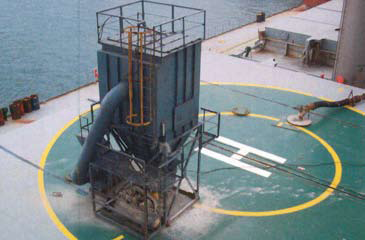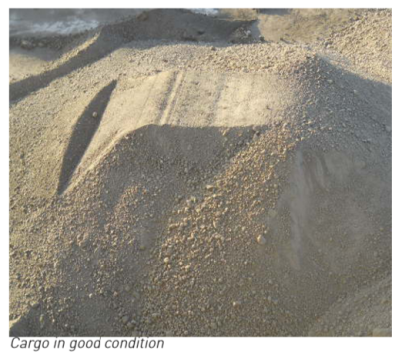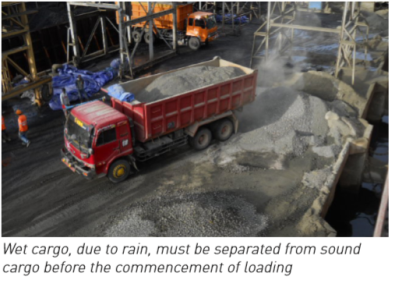
Fig: Loading cement using a closed loading system
Precautions
Appropriate precautions shall be taken to protect machinery and accommodation spaces from the dust of the cargo. Bilge wells of the cargo spaces shall be protected from ingress of the cargo.
Person who may be exposed the dust of the cargo shall wear protective clothing, goggles or other equivalent dust eye protection and dust filter masks, as necessary. Bilge wells shall be clean, dry and covered as appropriate, to prevent ingress of the cargo.
The loading process into holds results in the creation of large amounts of cement dust settling on all exposed areas. All areas must be swept and/ or washed down after the completion of loading to prevent loose cement from hardening if exposed to seawater or rainwater during the vessels journey
Carriage
After completion of loading of this cargo, the hatches of the cargo spaces shall be sealed as necessary. All vents and access ways to the cargo spaces shall shut during the voyage. Bilges in the cargo spaces carrying this cargo shall not be pumped unless special precautions are taken.
Discharge
Discharge should not be undertaken during periods of bad weather. Charterers may be asked for a LOI if they insist on discharge. This would usually serve to place all liability and damage risks on charterers. If charterers have CLH cover, that could be prejudiced by the terms of the LOI.
After discharge, dry residue and pockets of cement remain loosely adhered to exposed surfaces in the hold, including bilge wells, cargo hold bulkheads, hatch cover undersides and hatch coamings. ´ The cement dust in these areas should be cleaned using brooms, brushes and air guns with the help of Cherry Pickers. When all cement dust has been swept away, all areas should be washed with seawater using high pressure hoses (2,500 psi).
If there is semi-hardened cement visible on the hold surfaces, a more aggressive approach should be employed from the start. Stiff bristle brushes and hand scrapers should be used to remove as much as the cement as possible. If hardened, pressure hoses will not successfully remove the cement and only worsen the situation. Water will aid in the hardening process of the cement, causing more damage and further delaying the cleaning process
If manually sweeping and scraping the surface does not remove the hardened cement, additional equipment such as very high pressure washers (20,000 psi) may have to be loaded on board. These are expensive, extremely heavy and cause delay.
If the hard residues can still not be removed by high pressure water/air, it may become necessary to remove the hardened cement with acid cleaners or specialized machines. The acid may cause damage to the hold paint and thus must be diluted with freshwater. Check the hold paint manufacturers recommendation as to which acid cleaners they suggest be used. Acid cleaners must be used with great precaution as they can cause harm to the cleaning crew. Material Safety Data Sheets should always be consulted.
Clean up
In the case that the residues of this cargo are to be washed out, the cargo spaces and the other structures and equipment which may have been in contact with this cargo or its dust shall be thoroughly swept prior to washing out. Particular attention shall be paid to bilge wells and framework in the cargo spaces. The fixed bilge pumps shall not be used to pump the cargo spaces, because this cargo may make the bilge system inoperative.
Example
Loading port: Kanda - Japan
Discharging port : -Kwinana-Australia
Facing problems
A wide variety of problems can exist when carrying cement. When vessels have sailed around the Cape, the cement cargo stored underneath other cargoes is often damaged in the bad weather as it has not been adequately protected or packed. Cement cargoes also run the risk of becoming caked due to water ingress.
One of the major causes of cargo damage in some ports is due to improper handling of the cargo by stevedores; this results in torn cement bags spilling cargo in the hold. Problems often occur due to mismanagement of the cranes and machinery, meaning bags are dropped, which could be very dangerous and can result in cargo being lost over the side. Additionally, theft is a noticeable problem and reminded to remain vigilant.
Things to do
- masters should confirm that weather routing advice takes account of the water-sensitive nature of the cargo carried. Masters should let it be known when they have reservations
- stevedores and charterers should be approached when incorrect loading equipment is used
- before loading cement or other dusty cargoes, the coaming drain holes should be taped over to prevent the entry of dust. Tape should be removed before blowing down
- after a closed loading operation, the trackways should be cleaned if possible and cleared to free the drain holes, (if the weather allows). Masters should advise their owners and charterers of this requirement
- Make sure the holds are clean and dry before loading
- Be extremely careful if the vessel has previously carried a cargo of sugar
- Conduct an ultrasonic test before loading to ensure hatch covers are weather tight
- Discourage loading and unloading during periods of bad weather
- Discourage loading cargo at very high temperatures as this could produce water vapor in the holds
- After loading, ensure all cement dust is swept away from all exposed surfaces to prevent it from hardening on contact with rainwater or seawater
- Always ensure crew dealing with cement are provided and trained in using the appropriate PPE
- Consider carefully the cleaning method to be employed from the very start in the event of hardened cement on the hold surface. A wrong approach can exacerbate the situation, increase cleaning costs and cause significant delays
- Aim to include extremely specific clauses regarding delivery, re-delivery and cleaning obligations in the charterparty
- Know your obligations and liabilities under the charterparty
Read more on Bulk cement & clinker handling
Related Information
Hazards of handling bulk sulphur
Loading, carrying and discharging of bulk coal
Special arrangements for carrying grain cargo
Risk of carrying high density iron ores in bulk
Cargo liquefaction & potential problem for transporting bulk cargo
Our detail pages illustrated many safety aspects of Bulk carrier
Home page |||Bulk carrier types ||| Handling of bulk coal |||Cargo planning ||| Carriage of grain |||Risk of iron ores |||Self unloading bulk carriers |||Care of cargo & vessel |||Cargoes that may liquefy |||Suitability of ships |||Terminal guideline |||Hold cleaning |||Cargo cranes |||Ballast handling procedure |||Bulk carrier safety |||Fire fighting systems |||Bulk carrier General arrangement
Top articles
- Bulk carrier types - Ore carriers, OBO ships, forest product carrier , self unloader and more
- Care of cargo during loading- Trimming pours
- Checklist for confirming stabilty and hull stress prior loading
- Cargo loading agreement between ship and terminal
- Bulk carrier loading manual
- Handling of deballasting (ship duties) during high loading rate
- Cargo and ballast handling guide
- Responsibility of ship during cargo operation
- Shipboard hazards & bulk carriers safety guideline
- Asymmetric cargo and ballast distribution for bulk carriers
- Limitations on exceeding load lines
- Risk of deviation from the loading limitations
- Cargo handling guidance for deck officers
Ventilation requirement for bulk cargo loaded
- Preparation for ships carrying bulk cargo & standard loading condition
- Monitoring cargo operation safety checks in a bulk terminal
- How to avoid cargo damage by applying proper ventilation methods
- Measures against liquefaction of bulk cargo
- How to plan cargo discharge in a safe manner ?

Operation of sea going bulk carriers involved numerous hazards . Careful planning and exercising due caution for all critical shipboard matters are important . This site is a quick reference to international shipping community with guidance and information on the loading and discharging of modern bulk carriers so as to remain within the limitations as specified by the classification society.
It is vital to reduce the likelihood of over-stressing the ship's structure and also complying with all essential safety measures for a safe passage at sea. Our detail pages contain various bulk carrier related topics that might be useful for people working on board and those who working ashore in the terminal. For any remarks please Contact us
Copyright © 2010 bulkcarrierguide.com All rights reserved.
Although every effort have been taken to improve the accuracy of content provided the publisher of this website cannot gaurantee for errors. Disclaimer Privacy policy Home page



